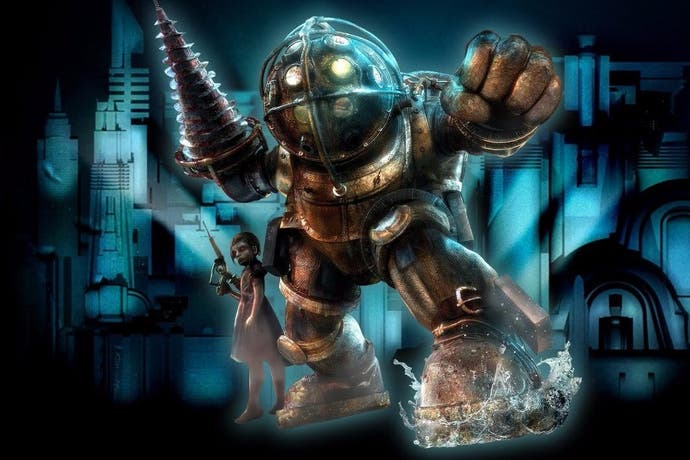Face-Off: BioShock: The Collection
Some nice upgrades are marred by obvious technical issues.
On paper, the package looks compelling. The original BioShock, its underrated sequel and all the DLC are treated to a full remaster for their current-gen console debuts, plus there's a full port of BioShock Infinite, offering the complete PC package for PS4 and Xbox One owners. On top of that, 2K Games has aimed high in terms of performance and image quality, with 1080p resolution and 60fps action targeted for all three titles.
Now in theory, this shouldn't cause any issues for the first two games in the series, at least. After all, despite their striking visuals, BioShock and its sequel are actually based on a modified form of Unreal Engine 2.5, a relatively ancient game engine originally deployed in the PS2 and original Xbox era. On top of that, BioShock Infinite - despite its various streaming glitches - proved to be a mostly solid piece of PC code, the ideal basis from which to port to PS4 and Xbox One, so hopes were high going in here.
Additionally, there's good news for PC owners of the original games too - they get immediate access to all of the remastering work with no further cash outlay required. This is a generous move on the part of 2K, bearing in mind that conversion-smith Blind Squirrel Games has clearly poured a lot of time and effort into bringing BioShock and its sequel into the modern gaming era - there's revamped lighting, new models, and higher resolution textures grafted into the first two games. Additionally, all three titles benefit from the inclusion of a director's commentary, unlocked by discovering new items added to each version of the game.
Having grown resigned to barebones remasters - like most of Capcom's recent output - that take the form of straight ports with very little in the way of enhancements, there's definitely the sense that 2K has at least put the time, effort and money in here. However, what should have been a successful launch has been impacted by an avalanche of bug reports, complaints about aspect ratio support, mouse control issues plus the lack of surround sound.
There's little doubt that the Collection is a little rough around the edges right now, but for our money, there's another important issue to address here - can enhancing an original work go too far? What if the changes made don't always seem respectful to the source material? Could it actually be the case that the new versions actually look worse than the originals in some scenarios?
First up, it's plain to see that both BioShock and its sequel benefit from massively improved texture work that runs across the entire game. To the credit of the developer, it seems that almost every aspect of the game has been substantially revamped - in addition to core artwork that better scales to today's 1080p resolution standard, environmental detail has also been upgraded with improved geometry.
In addition, in-game models also benefit from a ground-up approach, clearly boasting significantly more detail. However, it's frustrating to see a poor level of texture filtering in place, meaning that ground textures in particular suffer when viewed at oblique angles - the benefits of the remastering work can seemingly vanish in some scenarios.
However, it's actually the changes made to the core aesthetic that are more of a concern. Rapture is a city under the sea, with the original developers making that felt throughout the game with a strong, shiny specular component giving the sense of wet floors and a 'moistness' across the whole game. This is massively toned down throughout the remastered titles. Even the textures used for rushing water are seemingly dialled back, removing some of the original's look and feel.
On top of that, audio is clearly an issue. Sound is obviously more compressed compared to the original, reverb is missing and even some of the smaller sound effects are absent, such as the tape reel noise on playing back a diary recording. The audio mix itself feels flatter and more level and it all comes across as a substantial downgrade. The PC version is also locked to stereo output, and owing to the pared back settings menu, it actually requires dipping into the .ini files to force out the surround mix.
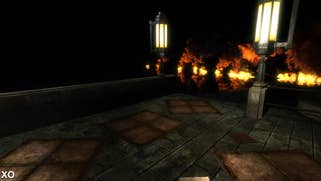
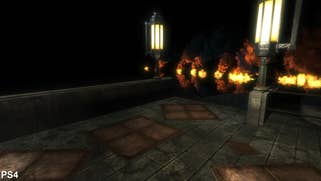
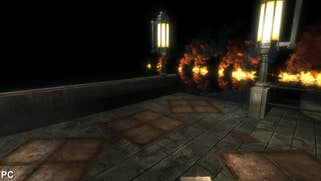





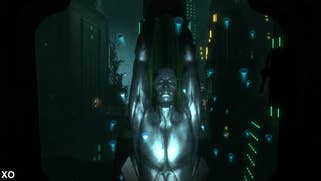



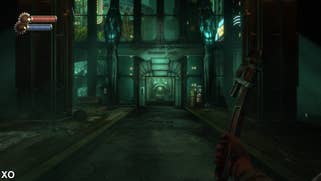


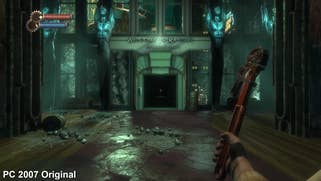






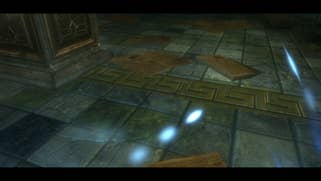
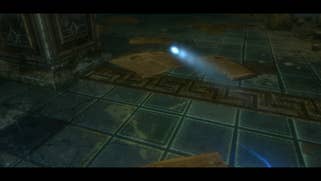

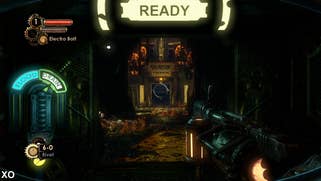







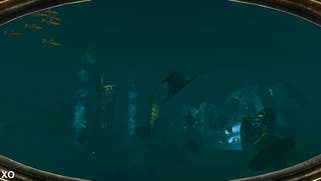


Overall, there's the sense that BioShock isn't a bad remaster as such. Clearly, a lot of work has gone into revising the title. It's just that the new artistic direction for the remaster - and the lighting in particular - doesn't always feel quite right. And on top of that, the bugs and glitches reported by many (our playthrough was relatively trouble-free) are matched by issues in performance. Both PS4 and Xbox One operate with an adaptive v-sync, which sees tearing and frame-rate drops kick in when there's heavy effects work. This is difficult to justify given the age of the original release and the fact that the core engine is actually around 15 years old now. Whether you're on PS4 or Xbox One, you'll be encountering the same issues.
Moving onto BioShock 2, and there's a sense of more of the same. Certainly in terms of performance, there's the same 1080p60 target, but the same shortfall in effects-heavy scenes. In terms of the aesthetic, many of the same gripes from the first title apply to this one. There's a big drop in specular lighting, removing much of the 'wetness' of the city aesthetic. Going underwater, detail actually looks significantly pared back compared to the original release - a consequence of a murkier, perhaps more realistic look, but still at odds with the presentation of the older code. However, the developer does deserve kudos for its revamp of the textures and models - we even spotted some parallax occlusion mapping on some of the ground textures here. That's an example of modern day GPU features grafted on to the original game while still being respectful to the original artwork.
In terms of PS4 vs Xbox One comparisons, it's actually the Microsoft platform that gets the nod here. While the original BioShock is essentially identical on all formats, light sources and bloom are missing from many scenes on the PS4 title, giving a dull, less vibrant look to the game. Bearing in mind the platform parity we see on the original game, we can only think that this is a bug - one that will hopefully get resolved in the upcoming patch.
Finally, the BioShock Collection also includes port of BioShock Infinite - the concluding chapter in the trilogy. Now, this is an interesting one. It's a straight port of the existing PC code to consoles, and 2K hasn't felt the need to re-issue the game on PC at all as a consequence. So the question is really to what extent the developer has been able to attain its 1080p60 target, while at the same time retaining as much of the original PC release's features. After all, if there are performance and texture filtering issues on the console versions of BioShock 1/2, how well will the same hardware stand up when running a much more ambitious title?
Well, on the plus side, the developer does at least have a modern DX11 codebase available on which to build its ports, and Irrational Games put a lot of effort into developing a multi-threaded engine capable of exploiting Xbox 360's six hardware CPU threads, not to mention the six available SPUs on PS3. This also has benefits for PC and the current-gen consoles too, but it's clear that the developers still had issues in porting across the full fat BioShock Infinite experience.
In terms of visual features, texture filtering is of a remarkably poor quality on PS4 (looking much better on Xbox One), while bloom effects are dialled down, PC's higher quality depth of field gets a downgrade while ambient occlusion also suffers. Shadow quality is also significantly reduced too. There are other curiosities too, such as some missing reflections on the PS4 version of the game. Xbox One holds up, perhaps owing to its access to the DirectX 11 API.

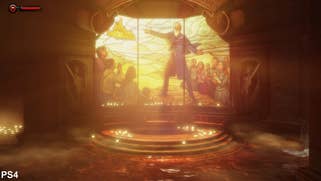










However, it has to be said that the cutbacks to visual features - PS4 texture filtering apart - don't really tend to impact on the quality of the game experience and only become evident in direct side-by-side comparisons. Unfortunately, BioShock Infinite on both PS4 and Xbox One is marred by some very choppy performance. 1080p60 is the target and initially it seems as if the developer has done a good job here on the port, but as you progress through the opening level, it becomes clear that the consoles suffer from the same kind of streaming problems that marred the original PC version of the game. On top of that, as both PS4 and Xbox One operate from relatively slow laptop-style hard drives, it actually feels a whole lot worse, with the Microsoft platform in particular suffering badly with some mammoth frame-time spikes.
Outside of the streaming issues, both console versions of Infinite have their own individual performance throttle-points. Combat in particular seems to be a bugbear, with some big drops to frame-rates marring visual feedback and response just when you need it most. In these areas, on balance, Xbox One seems to hold up a little better - a contrast to the streaming glitches, where it really tends to suffer badly.
It's the lack of consistency that really impacts the overall quality of the experience here. At the very least, v-sync is enabled throughout, but this only serves to emphasise some of the performance issues during combat. Bearing in mind that the developers haven't improved on any aspect of the original game here, it's disappointing that more time couldn't have gone into addressing the clear performance issues. BioShock Infinite still stands up in terms of its gameplay and assets, but the frame-rate glitches are much worse than they should be - and ideally, they shouldn't be there at all.
BioShock: The Collection - the Digital Foundry verdict
Coming out of this one, it's clear that PC owners get the best deal here. If you own BioShock and its sequel, you get immediate access to the remasters, effectively giving you a choice between two visions of the game. You can sample the new work and see if it's for you, or just drop back to the original releases if you feel that the changes go a little too far. Additionally, PC hardware can push beyond the limitations of the consoles and deliver the locked 60fps experience we want. On top of that, BioShock Infinite may not be perfect in its PC incarnation, but it's light on CPU and GPU resources, highly scalable and looks better than the console versions, running better on a wide range of hardware. Finally, the fact that all of the games are of a certain age means that picking up Steam keys for each shouldn't cost that much.
The console remasters are a mixed bag. Performance is an issue on the first two titles - we really shouldn't be seeing frame-rate drops and tearing on titles as basic as this - but it really comes to the fore in BioShock Infinite, where it's much more impactful to the game's visual consistency and basic playability. But if there's a sense of disappointment with Infinite, at least the remasters for the older titles shows an attempt to update and improve the assets for the modern console era. We aren't entirely sure if the right artistic decisions were made, but these are not 'lazy' remasters - clearly a lot of effort has gone into them. They just lack a certain degree of polish, a common complaint with software these days, it seems.
We've concentrated on PC comparisons in our coverage thus far, but the state of play versus the original console releases is worth touching upon. BioShock and its immediate sequel are clearly hugely improved over both Xbox 360 and especially PS3, and the move up to 1080p60 adds significantly to the playability of titles. Meanwhile, BioShock Infinite had performance issues of its own back in the day, so there is an improvement here. But overall, there's the sense that all three titles lack the required polish, and we hope that the upcoming patches can resolve the key issues here.
